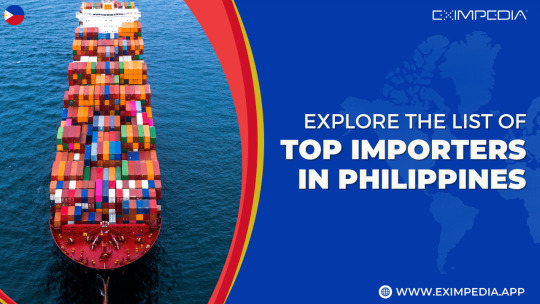#hs code
Explore tagged Tumblr posts
Text
Vietnam Imports Data 2025: Top Vietnam Importers, Imports by Country, & Import Trends
Vietnam is one of Southeast Asia's most dynamic economies, with a growing import market. As we look ahead to Vietnam imports data 2025, it's essential to understand the top Vietnam importers list, Vietnam trade statistics, and trends shaping the country's economy. The data not only helps businesses to identify potential opportunities but also enables importers and traders to gauge market conditions.
In this blog, we'll dive into the Vietnam imports by country, top importers in Vietnam, Vietnam HS code data, and more. We will also provide insights into Vietnam import value 2024 and top Vietnam imports 2024-25 to give a comprehensive view of the market. Let’s explore what’s on the horizon for Vietnam imports trends 2025.
Understanding Vietnam's Import Landscape in 2025
Vietnam's import market is expected to continue its upward trajectory in 2025. With the global economy evolving and Vietnam strengthening its trade relations, understanding Vietnam customs data and Vietnam importers data is crucial for anyone engaged in cross-border trade.
Vietnam’s key import categories span several industries including machinery, electronics, petroleum products, chemicals, and food products. These industries contribute significantly to Vietnam's import value and play an essential role in the supply chain for its domestic manufacturing and export-driven industries.
Key Vietnam Importers & Market Players
Some of the top importers in Vietnam include large corporations operating in various sectors. These companies are responsible for a significant portion of Vietnam’s imports, especially in sectors like electronics, machinery, and industrial equipment.
For a detailed breakdown of Vietnam importers data and insights on which companies are leading the charge in imports, you can visit our detailed page on Vietnam Importers List 2025.
Vietnam Imports by Country
Vietnam’s imports are diverse, with products coming from a wide range of countries. Some of the Vietnam’s top trade partners include China, South Korea, Japan, the United States, and the European Union. These countries are significant contributors to Vietnam's import market, with China being the largest source of imports, particularly for raw materials and machinery.
Analyzing Vietnam imports by country is essential for businesses looking to identify new markets for sourcing or those aiming to expand trade in the region. Whether it's understanding Vietnam HS code data for specific products or assessing the Vietnam import trends 2025, knowing your trading partners can help businesses plan their imports effectively.
Top Vietnam Imports 2024-25
In 2024-25, Vietnam's imports are projected to see continued growth, particularly in the following sectors:
Machinery and Electrical Equipment: This category continues to be one of Vietnam’s largest imports, driven by demand in manufacturing and construction industries.
Petroleum and Mineral Fuels: With growing energy consumption, Vietnam is expected to increase its import of crude oil and refined petroleum products.
Automobiles and Parts: As the Vietnamese economy continues to develop, the demand for vehicles and auto parts remains strong.
Consumer Goods: Food, beverages, and personal care products make up a significant portion of consumer imports.
Vietnam Import Value 2024: A Snapshot
As of 2024, Vietnam's import value has surged, reflecting the nation's strong economic recovery and robust manufacturing base. The Vietnam import value 2024 is projected to exceed earlier predictions, driven by industrial needs and consumer demand. Understanding this import value helps in predicting future trends and setting realistic import targets for the years ahead.
Vietnam Import Trends 2025: What to Expect
As Vietnam continues to expand its trade and strengthen economic partnerships globally, the Vietnam import trends 2025 suggest growth in high-tech products, machinery, and raw materials. Additionally, shifts in global supply chains, changes in trade agreements, and regional economic integration will further influence these trends. Keeping an eye on Vietnam importers list and staying updated on Vietnam customs data can provide a clearer understanding of how the market will evolve.
For more details on Vietnam imports trends 2025, including specific product categories and Vietnam HS code data, you can read more on our dedicated page: Vietnam Imports Data 2025.
Conclusion
In conclusion, the Vietnam imports data 2025 will show continued growth, fueled by industrial expansion, growing consumer demand, and strengthened international trade relationships. The country's top importers and trade statistics reveal significant opportunities for businesses looking to enter the market. Understanding Vietnam import trends, tracking imports by country, and analyzing Vietnam importers data are key to making informed decisions.
For businesses involved in importing or planning to expand into Vietnam, keeping an eye on these trends and utilizing resources like Vietnam HS code data will provide a solid foundation for success.
#vietnam data#Vietnam import data#vietnam import#vietnam#import#global trade data#vietnam export data#import trends#HS code#trade statistics#news#social accounts#skz
0 notes
Text
Customs Clearance
🧾 What Is Customs Clearance? Customs clearance is the process of getting goods approved for import or export through legal channels. It involves preparing documents, calculating duties, and ensuring compliance with customs regulations. Without proper clearance, cargo can be delayed, fined, or even seized. ✅ Why Use Keenam International for Customs Clearance? As a licensed freight forwarder and…
#bea cukai#customs broker#customs clearance#freight forwarder Indonesia#HS code#import export#logistics jakarta#PEB#PIB
0 notes
Text
Customs Clearance
🧾 What Is Customs Clearance? Customs clearance is the process of getting goods approved for import or export through legal channels. It involves preparing documents, calculating duties, and ensuring compliance with customs regulations. Without proper clearance, cargo can be delayed, fined, or even seized. ✅ Why Use Keenam International for Customs Clearance? As a licensed freight forwarder and…
#bea cukai#customs broker#customs clearance#freight forwarder Indonesia#HS code#import export#logistics jakarta#PEB#PIB
0 notes
Text
বাংলাদেশে ব্যবসার জন্য HS কোডের ভূমিকা ও এর প্রয়োজনীয়তা
HS Code বা Harmonized System Code পণ্য আমদানি ও রপ্তানির জন্য গুরুত্বপূর্ণ একটি কোড। hs কোড ব্যবহারের মাধ্যমে পণ্যগুলোর সঠিক শ্রেণিবিন্যাস করা যায়, যা শুল্ক ও কর নির্ধারণ সহজতর করে। এটি ব্যবসায়িক প্রক্রিয়া যেমন কাস্টমস ক্লিয়ারেন্স এবং আন্তর্জাতিক লেনদেন আরও দ্রুত ও কার্যকর করতে সাহায্য করে। বাংলাদেশে সঠিক HS কোড ব্যবহারে পণ্যের শ্রেণিবিন্যাস নির্ভুল হয় এবং ব্যবসায় শুল্ক কমে আসে, যা সময় �� খরচ বাঁচায়।
#বাংলাদেশে#HS Code#পণ্য শ্রেণিবিন্যাস#আমদানি রপ্তানি কোড#শুল্ক নির্ধারণ#পণ্য সনাক্তকরণ#বাংলাদেশ কাস্টমস কোড#ট্রেড কোড#ব্যবসায়িক নির্দেশিকা
0 notes
Text
Top 10 Importers in the Philippines
The Philippines, an island nation known for its breathtaking landscapes and rich cultural heritage, is also notable for its significant reliance on imported goods and Importers in the Philippines. Despite its abundant natural resources, the country imports a vast array of commodities due to geographical constraints and insufficient domestic production. In 2023, the Philippines imported goods worth US$159.29 billion, reflecting its substantial dependence on international trade.

Major Imports of the Philippines
The primary imports of the Philippines encompass a wide range of products essential for various sectors of the economy. These include:
Agricultural Products: Due to limited arable land, the Philippines imports significant quantities of food grains, including rice, to meet its domestic needs.
Minerals and Metals: Essential for the country's industrial sector, imports of minerals and metals, including iron and ore, are crucial.
Energy Resources: Petroleum, coal, and other energy resources are major imports necessary for sustaining the country’s energy requirements.
Transportation Equipment: Automobiles and other transportation-related equipment are regularly imported to support the growing infrastructure.
Pharmaceutical Products: The healthcare sector relies heavily on imported pharmaceutical products to ensure the well-being of its population.
Top Import Partner of the Philippines
The Philippines' top import partners are key to understanding the flow of goods into the country. These partners include:
China: US$29 billion
Indonesia: US$13.9 billion
Japan: US$13 billion
South Korea: US$12.7 billion
United States: US$9.69 billion
Singapore: US$8.46 billion
Thailand: US$7.65 billion
Malaysia: US$6.68 billion
Vietnam: US$4.77 billion
Other Asian Nations: US$7.09 billion
Top Importers in the Philippines
Several prominent Importers in the Philippines are key players in the import market. These include:
Nike Philippines, Inc.
Imports sports and athletic products primarily from Thailand, worth approximately $65,000 annually.
HS Codes: 61034300000, 61045300000, 61099020000
Port: Manila International Port
Johnson & Johnson, Inc., Philippines
A leading healthcare brand importing goods worth about $70,000 annually from Malaysia.
HS Codes: 34013000000, 33049930000, 33051090000
Port: Manila
Shin Etsu Magnetics Philippines Inc.
Imports magnetic products from Malaysia, valued at around $3.3 million annually.
HS Codes: 85051900000, 85051100000
Port: Manila International Container Port
Trans Tec Intl. Mktg Phils Inc
Engages in the marketing and distribution of electronics, importing goods worth $55,000 annually from South Korea.
HS Codes: 85149090000, 85044040000, 84212119000
Audio Video Solutions Corporation
Imports high-quality audio and video technology products from China, worth over $90,000 annually.
HS Codes: 851810900000, 85182290000
Bakels Philippines Inc.
Dominates the bakery ingredients market, importing goods worth at least $100,000 from Switzerland, Sweden, and China.
HS Codes: 021020000, 39232119000, 21021000000
Port: Manila International Container Port
HP PPS Philippines, Inc.
A subsidiary of HP Inc., importing semi-finished and finished technology products valued at $200,000 from Vietnam, China, and Malaysia.
HS Codes: 84433239000, 84439990000, 84439920000
Jejors Construction Corporation
Imports construction-related goods valued at around $60,000.
HS Codes: 84295200000, 84295200000, 84791010000
Port: MCT-Phividec
Amkor Technologies Philippines, Inc.
Imports semiconductor products valued at $55,000 from the USA and Ireland.
HS Codes: 85411000000, 85411000000, 85411000000
Rikio Southeast Asia Inc.
Imports raw materials for footwear manufacturing from China, Pakistan, and South Korea, valued at around $50,000 annually.
HS Codes: 39204900000, 52079000000, 39201019000
The Dependency on Imports
The Philippines’ heavy reliance on imports is influenced by several factors, including limited agricultural land and the need for various raw materials and finished products. While the country aims to increase agricultural self-sufficiency, achieving this will require substantial investment and time. The dependency on imports, particularly for essential goods like food and energy, underscores the importance of robust international trade relationships.
Conclusion
Understanding the import landscape of the Philippines reveals its complex economic dependencies and the critical role of international trade. Key import partners and major importers in the philippines are essential to the country's economy, helping meet the diverse needs of its population. For businesses seeking updated information on importers in the Philippines, platforms like Eximpedia offer valuable insights and comprehensive data to support informed trade decisions.
By leveraging accurate and up-to-date import data, traders can effectively navigate the Philippine market and enhance their business operations in this dynamic region.
0 notes
Text
What Is HS Code In Shipping?
Understanding the Harmonized System (HS) code is crucial for international shipping. Here's a breakdown of what the HS code is and its significance in shipping:
Definition: The HS code is an internationally standardized system of names and numbers used to classify traded products.
Structure: It consists of six digits, with additional digits for more detailed classification.
Global Recognition: Used by over 200 countries, making it universally recognized in international trade.
Customs Clearance: Helps customs authorities identify and categorize goods for duty and tax assessment.
Logistics: Enables accurate tracking and handling of goods throughout the shipping process.
Trade Statistics: Facilitates the compilation of trade data at a global level.
Having the correct HS code for your product is essential for smooth customs clearance and compliance with international shipping regulations.
Read ahead for more information

0 notes
Text
Explore Seair Exim Solutions to discover the HS code for your product, facilitating seamless international trade. Our expert guidance ensures accurate classification and smooth import-export processes. Connect with us today to streamline your business operations!
0 notes
Text

When it comes to HSN codes, Seair Exim Solutions stands out as your trusted partner. We specialize in providing comprehensive HSN code and solutions to streamline your import-export processes. With our expertise, you can easily navigate the complex world of international trade. Whether you want to classify your products or comply with customs regulations, we've got you covered. Trust us to simplify your HSN code requirements and enhance your global trading experience.
0 notes
Text
Unveiling the Power of HS Code Data: A Comprehensive Guide

In the world of international trade, understanding the Harmonized System (HS) and its corresponding HS code data is paramount. HS code data, also known as Harmonized System codes, is a standardized classification system used globally to categorize and identify products for customs and trade purposes. In this comprehensive guide, we will delve into the various aspects of HS code data, its importance, and how it plays a pivotal role in facilitating seamless international trade.
Understanding HS Code Data
What is an HS Code?
At its core, an HS code (Harmonized System code) is a numerical classification used to identify and categorize products for international trade. These codes are universally recognized and ensure that products are classified consistently across borders, promoting clarity and efficiency in global commerce. Each HS code is made up of six to ten digits, with the higher number of digits providing more precise product information.
The Structure of HS Codes
HS codes follow a hierarchical structure, with the first six digits representing the global classification of a product. These six digits are common to all countries using the HS system and are known as the HS "heading." The additional digits, often referred to as "subheadings," can vary from country to country and provide more specific details about the product. For example, while the first six digits might identify a product as "footwear," the additional digits can distinguish between different types of shoes, such as sneakers or dress shoes.
The Importance of HS Code Data
Facilitating International Trade
HS code data serves as a common language for international trade. When a product is assigned an HS code, it becomes universally recognized, making it easier for customs authorities, importers, exporters, and logistics providers to identify, classify, and process goods efficiently. This standardization minimizes errors and reduces delays in the clearance process, ultimately fostering smoother cross-border transactions.
Tariff Classification
One of the primary uses of HS code data is in determining tariff rates for imported and exported goods. Governments around the world use HS codes to levy customs duties and taxes on products entering or leaving their borders. By correctly classifying products with the appropriate HS code, businesses can ensure they pay the correct tariff rates, thereby avoiding overpayment or disputes with customs authorities.
Trade Statistics and Analysis
HS code data plays a crucial role in generating trade statistics and conducting market analysis. Governments, trade associations, and businesses use this data to monitor international trade trends, track the flow of goods, and identify emerging markets and opportunities. Access to accurate and up-to-date HS code data can provide valuable insights for businesses looking to expand their global reach.
Challenges and Considerations
Complex Classification
While the HS system provides a standardized framework for classification, determining the correct HS code for a product can be challenging. Some products may fall into multiple categories, making it necessary to consult customs authorities or experts for accurate classification. Misclassification can lead to costly errors in tariff assessment.
Frequent Updates
The HS system undergoes periodic updates to accommodate changes in technology, trade practices, and product innovation. Staying current with these updates is essential for businesses to ensure compliance with changing regulations and to accurately classify their products.
Regional Variations
Although the first six digits of an HS code are globally standardized, some countries add additional digits to create their own national codes. These variations can complicate international trade, as businesses must be aware of both global and local classifications when navigating cross-border transactions.
Utilizing HS Code Data for Success
Leverage Technology
In today's digital age, various tools and software solutions are available to assist businesses in classifying their products with HS codes accurately. These tools can streamline the classification process, reduce errors, and ensure compliance with international trade regulations.
Seek Professional Guidance
For complex products or industries, consulting with customs experts or trade professionals can be invaluable. These experts can help determine the correct HS code for a product, reducing the risk of misclassification and potential disputes with customs authorities.
Conclusion
In the intricate world of international trade, HS code data is the glue that holds everything together. Its standardized classification system not only simplifies the identification of products but also plays a pivotal role in tariff assessment, trade analysis, and compliance. Businesses that harness the power of HS code data can streamline their global operations, minimize risks, and unlock new opportunities in the global marketplace. Whether you are an importer, exporter, or simply curious about the world of international trade, understanding HS code data is an essential key to success.
0 notes
Note
could i request some porrim? you're one of my favorite porrim artists <3

Hell yeah!! I love drawin her <3
#we should start referring to homestuck characters like the house from house of leaves they're already color coded#also sorry!! this ask is from april oops#oh and her shirt is supposed to say “it's hard being the hottest bitch here but someone has to do it”#porrim maryam#homestuck#hs#my art#ask#bathypelagicorchestra
225 notes
·
View notes
Text
Customs Broker
🧾 What Is a Customs Broker? A customs broker is a licensed logistics expert who facilitates the legal movement of goods across borders by preparing and submitting all required documents, calculating duties, handling HS code classification, and ensuring compliance with import/export laws. Using a professional customs broker helps avoid: Shipping delays Costly penalties Goods being held at…
#customs broker#customs clearance Indonesia#Freight Forwarding#HS code#import export Indonesia#logistics jakarta#PEB#pialang bea cukai#PIB
0 notes
Text
Customs Broker
🧾 What Is a Customs Broker? A customs broker is a licensed logistics expert who facilitates the legal movement of goods across borders by preparing and submitting all required documents, calculating duties, handling HS code classification, and ensuring compliance with import/export laws. Using a professional customs broker helps avoid: Shipping delays Costly penalties Goods being held at…
#customs broker#customs clearance Indonesia#Freight Forwarding#HS code#import export Indonesia#logistics jakarta#PEB#pialang bea cukai#PIB
0 notes
Text

#hs meme#homestuck#easter meme#june egbert#june is literally so Easter coded I can't believe I only just realized#bunny. eg(g)bert. rise up/is risen. holy shit
35 notes
·
View notes
Text

Another "Thank You" doodle! I'm not putting names: each one will know what they contributed to make me gather the courage to do this x)
#myart#predastar#tfp predaking#tfp starscream#maccadam#transformers fanart#shipping to the moon and back#legend says Windy draws art for this ship every leap year#jk jk its mostly because their designs make me want to foam from the mouth#I LOVE THEM THEY ARE PRETTY BUT WHY so hard to draw#this took me almost 3 hs and is just an sketch...#gotta color code this pairing with orange-y red filter#because i can see myself in the future doing it again and not wanting to color it pfff#good night i need to eat and keep working on zine artworks#king n commander#ifellinrobothellagain
235 notes
·
View notes
Text



thank u yuzuki and makoto for healing my yuri heart love u guys
@malaschinoo drew the sketch and lines for image 1 !!!! HEHE
#skip to loafer#skip and loafer#yuzumako#yuzuki murashige#makoto kurume#my art#i lvoe them#every chapter i read abt them i simply cry#mayb it is the simple joy of reading a hs piece of media n crafting such a loving lesbian coded relationship between two girls frm different#worlds ;---; i cry
119 notes
·
View notes
Text

Unlocking the Power of US Import Data: A Crucial Tool for Thriving in the Trade Business. Discover the significance of US import data in trade, and how it can supercharge your business success. Explore key insights and strategies in our latest blog.
0 notes